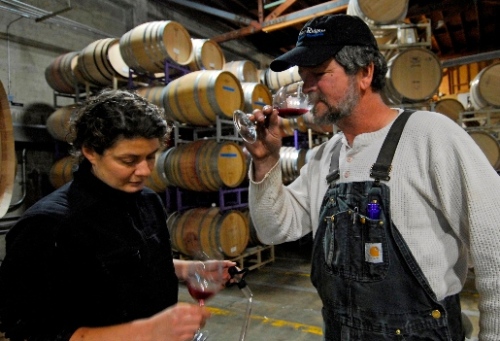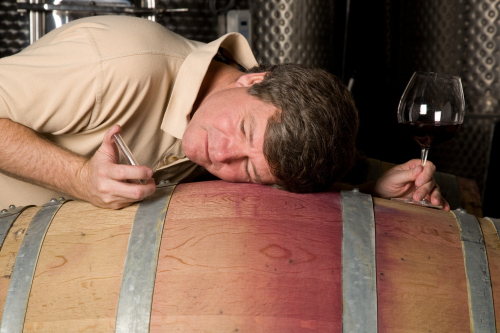Greg La Follette was born in Iceland. His wife came to the U.S. from Germany and together they have six children. I recently had a chance to talk with La Follette at his shared winemaking facility in Sebastopol.
How do you describe your style of winemaking?
I see myself as more of a translator of the land rather than a dictator or someone who just wants to do everything in a prescribed way. I let the land take the lead on things. I have a strong collaboration with growers and am on call 24/7 with them. A lot of winemakers don't have the plant biology training that I do. Nowadays many more winemakers are realizing that wine is best made in the vineyard and so winemakers are getting more viticulture training.
Why do you say you practice unsafe winemaking?
Well, we take risks. Safe winemaking is when you inoculate something, put in plenty of sulpher dioxide to knock out the bad guys, you put it at a temperature where its going to go through safely, you follow a formula. For us, frequently our fermentations don't finish until June, the following year from harvest, which adds layers of richness. If you like the taste of forest floor and mushrooms in your pinot, that’s a compound produced by grapes and it's brought forward when you provide oxygen at just the right time. It’s also about using your body, I have had broken ribs, torn rotator cuffs, concussions and other injuries. Our style of winemaking is a full contact sport.
Speaking of dialogues with your wines, why do you listen to your fermentations?
I am listening for the activity in the wine. That is a good clue for us to tell when we need to do things like add sulphur dioxide. Most winemakers, when the malolactic is done they say, “ok, lets add the sulphur dioxide now." And I say, “no, let's wait until they quiet down.” I am really focused on mouth feel, which means getting away from the hardness. By the way, the secondary fermentation has a different sound than the primary fermentation. But you have to spend the time listening, it's not that different than listening to your spouse or your kids. It makes for better relationships.
How do you describe mouthfeel?
It’s what I focused on when I was getting my Masters at U.C. Davis. Mouthfeel is how all the parts in the wine work together. It’s what brings pleasure to your mouth. They are broken down into three parts, entry, mid-palate and late palate. You have to tie together the whole union of the wine.
You follow some natural winemaking techniques which include using native yeasts and little filtration. What do you think of this trend which has received so much buzz?
Well, I think of minimalist interventions. But here is the problem, there is less manipulation with the more commercial style of winemaking. We are playing with our wines all of the time. We really and truly live the wine and are on top of our fermentations, literally, several times a day, smelling, looking, tasting.

La Follette with assistant winemaker Simone Sequeria. Photo: La Follette Wines.
How did you choose Pinot Noir as your grape, it is so challenging to make.
I like introducing people to what Pinot Noir can do. It can just love and caress your tongue. I finally had to surrender to it and say "take me I'm yours." Pinot is great to make if you have Chardonnay to give you a rudder of sanity. I wanted it to have weight and structure but be light and have it at a price point where we can make friends. It's a new label so that's important. (La Follette’s wines range from $29.99 to $49.99).
La Follette’s talent as a Pinot Noir maker may never have come to fruition had he not reached the conclusion that his first love, playing the bagpipes, was not a practical career. His dream as a teenager did not match his parents' career expectations of him. La Follette saved his milk money to pay, secretly, for lessons and eventually became a ship's piper on the Queen Mary. Now the bagpipes are a hobby to wind down from winemaking.
Since I have Scottish ancestry I assumed the bagpipes might be something I could pick up, after all, I can blow a lot of hot air. But I was quickly humbled after one short lesson from La Follette.
You can meet Greg La Follette and check out his wines at the “In the Cellar with Greg” series. The next one is scheduled for Friday, December 2. For more information you can go to "events" on his website.
This event is one in an occasional series on California winemakers.


